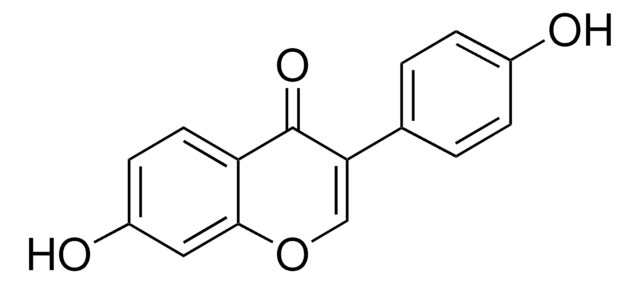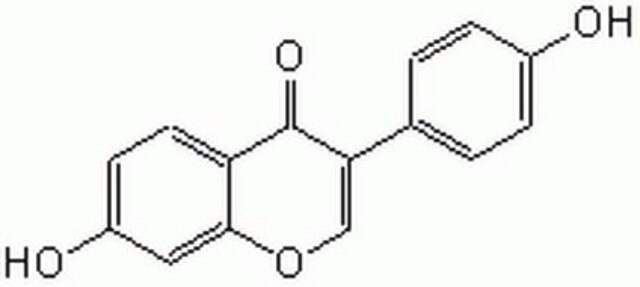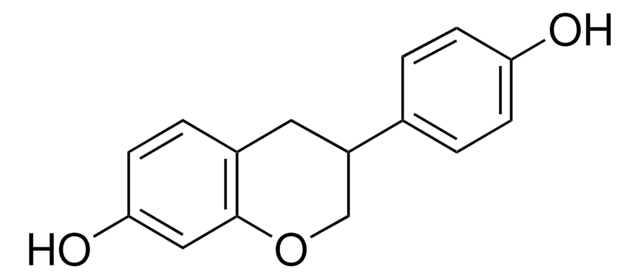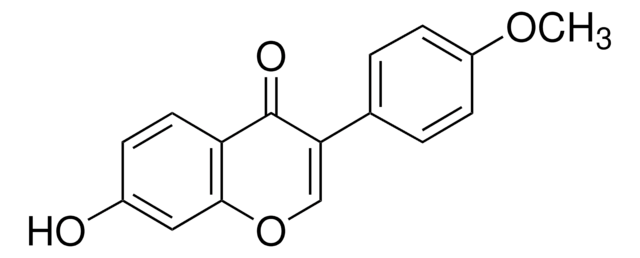D7802
Daidzein
≥98% (TLC), powder, carbonic anhydrase (CA) inhibitor
Synonym(s):
4′,7-Dihydroxyisoflavone, 7-Hydroxy-3-(4-hydroxyphenyl)-4H-1-benzopyran-4-one, 7-Hydroxy-3-(4-hydroxyphenyl)chromone, Isoaurostatin
About This Item
Recommended Products
product name
Daidzein, ≥98%, synthetic
biological source
synthetic
Quality Level
Assay
≥98%
form
powder
mp
>290 °C
solubility
DMSO: 10 mg/mL
storage temp.
−20°C
SMILES string
Oc1ccc(cc1)C2=COc3cc(O)ccc3C2=O
InChI
1S/C15H10O4/c16-10-3-1-9(2-4-10)13-8-19-14-7-11(17)5-6-12(14)15(13)18/h1-8,16-17H
InChI key
ZQSIJRDFPHDXIC-UHFFFAOYSA-N
Gene Information
human ... ESR1(2099) , ESR2(2100) , UGT1A4(54657)
mouse ... Aldh1a2(19378) , Hexa(15211) , Maoa(17161)
rat ... Aldh1a2(116676)
Looking for similar products? Visit Product Comparison Guide
General description
Application
- as a control to evaluate fertility in rats
- to study its effects on ovarian cancer
- to simulate in vitro antioxidant activity
Biochem/physiol Actions
Packaging
Signal Word
Warning
Hazard Statements
Precautionary Statements
Hazard Classifications
Eye Irrit. 2 - Skin Irrit. 2
Storage Class Code
11 - Combustible Solids
WGK
WGK 3
Flash Point(F)
Not applicable
Flash Point(C)
Not applicable
Personal Protective Equipment
Certificates of Analysis (COA)
Search for Certificates of Analysis (COA) by entering the products Lot/Batch Number. Lot and Batch Numbers can be found on a product’s label following the words ‘Lot’ or ‘Batch’.
Already Own This Product?
Find documentation for the products that you have recently purchased in the Document Library.
Customers Also Viewed
Articles
Serotonin (5-hydroxytryptamine) is principally found stored in three main cell types - i) serotonergic neurons in the CNS and in the intestinal myenteric plexus, ii) enterochromaffin cells in the mucosa of the gastrointestinal tract, and iii) in blood platelets. Metabolism of serotonin is carried out primarily by the outer mitochondrial membrane enzyme monoamine oxidase (MAO), which occurs as two molecular subtypes called MAO-A and MAO-B.
Antioxidants protect biological systems from oxidative damage produced by oxygen-containing free radicals and from redoxactive transition metal ions such as iron, copper, and cadmium.
Our team of scientists has experience in all areas of research including Life Science, Material Science, Chemical Synthesis, Chromatography, Analytical and many others.
Contact Technical Service










